初中英语听说课教案
- 格式:doc
- 大小:80.00 KB
- 文档页数:5
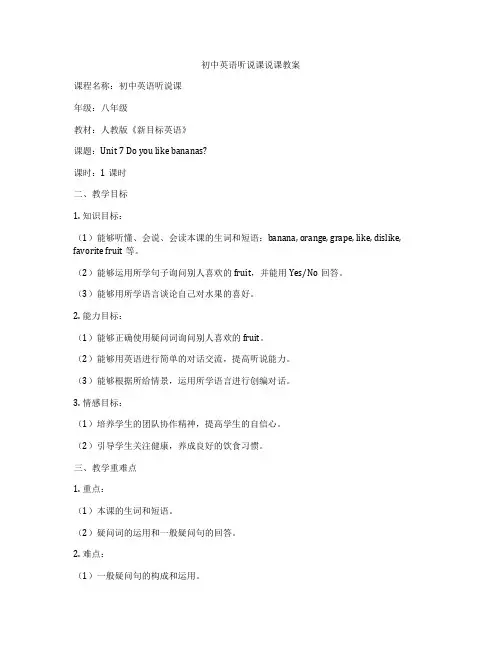
初中英语听说课说课教案课程名称:初中英语听说课年级:八年级教材:人教版《新目标英语》课题:Unit 7 Do you like bananas?课时:1课时二、教学目标1. 知识目标:(1)能够听懂、会说、会读本课的生词和短语:banana, orange, grape, like, dislike, favorite fruit等。
(2)能够运用所学句子询问别人喜欢的 fruit,并能用Yes/No回答。
(3)能够用所学语言谈论自己对水果的喜好。
2. 能力目标:(1)能够正确使用疑问词询问别人喜欢的 fruit。
(2)能够用英语进行简单的对话交流,提高听说能力。
(3)能够根据所给情景,运用所学语言进行创编对话。
3. 情感目标:(1)培养学生的团队协作精神,提高学生的自信心。
(2)引导学生关注健康,养成良好的饮食习惯。
三、教学重难点1. 重点:(1)本课的生词和短语。
(2)疑问词的运用和一般疑问句的回答。
2. 难点:(1)一般疑问句的构成和运用。
(2)情态动词 like 的用法。
四、教学过程1. 课前准备(1)准备与水果相关的水果图片和视频。
(2)准备录音机、磁带或音频文件。
(3)准备教学课件。
2. 课堂导入(1)向学生问候,引入课堂。
(2)通过展示水果图片和视频,引导学生谈论水果。
(3)利用问题引入本课主题:“Do you like bananas?”。
3. 新课呈现(1)呈现生词和短语,如banana, orange, grape, like, dislike, favorite fruit等,并进行认读练习。
(2)通过问答形式,引导学生运用疑问词询问别人喜欢的 fruit。
(3)讲解一般疑问句的构成和回答方式。
4. 听力训练(1)播放录音,让学生听懂对话内容。
(2)学生跟读对话,模仿语音语调。
(3)进行听力练习,如判断对错、选择答案等。
5. 口语练习(1)分组进行角色扮演,让学生运用所学语言进行对话。
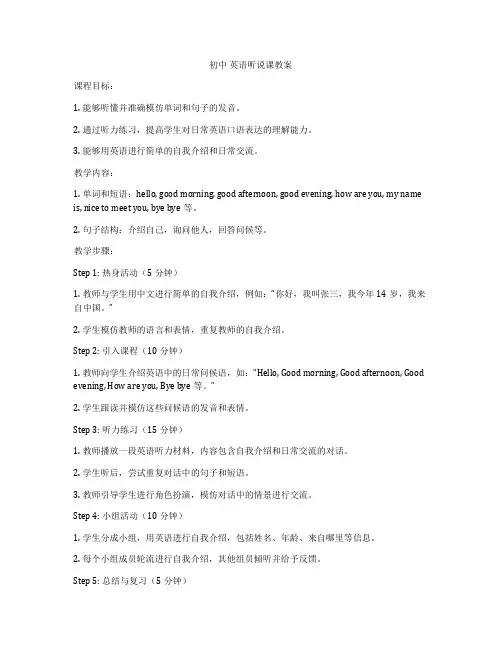
初中英语听说课教案课程目标:1. 能够听懂并准确模仿单词和句子的发音。
2. 通过听力练习,提高学生对日常英语口语表达的理解能力。
3. 能够用英语进行简单的自我介绍和日常交流。
教学内容:1. 单词和短语:hello, good morning, good afternoon, good evening, how are you, my name is, nice to meet you, bye bye等。
2. 句子结构:介绍自己,询问他人,回答问候等。
教学步骤:Step 1: 热身活动(5分钟)1. 教师与学生用中文进行简单的自我介绍,例如:“你好,我叫张三,我今年14岁,我来自中国。
”2. 学生模仿教师的语言和表情,重复教师的自我介绍。
Step 2: 引入课程(10分钟)1. 教师向学生介绍英语中的日常问候语,如:“Hello, Good morning, Good afternoon, Good evening, How are you, Bye bye等。
”2. 学生跟读并模仿这些问候语的发音和表情。
Step 3: 听力练习(15分钟)1. 教师播放一段英语听力材料,内容包含自我介绍和日常交流的对话。
2. 学生听后,尝试重复对话中的句子和短语。
3. 教师引导学生进行角色扮演,模仿对话中的情景进行交流。
Step 4: 小组活动(10分钟)1. 学生分成小组,用英语进行自我介绍,包括姓名、年龄、来自哪里等信息。
2. 每个小组成员轮流进行自我介绍,其他组员倾听并给予反馈。
Step 5: 总结与复习(5分钟)1. 教师引导学生复习本节课所学的单词和句子。
2. 学生用英语进行简单的日常交流,巩固所学内容。
教学评价:1. 观察学生在课堂上的参与程度和发音准确性。
2. 评估学生在听力练习中的理解能力和对日常英语口语表达的掌握程度。
3. 收集学生的小组活动反馈,了解学生在实际交流中的表现。
教学反思:本节课通过听说练习,帮助学生掌握日常英语口语表达的基本词汇和句型。
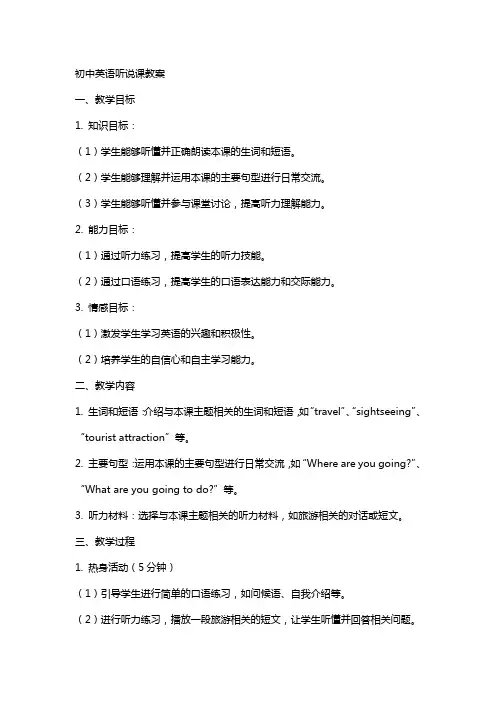
初中英语听说课教案一、教学目标1. 知识目标:(1)学生能够听懂并正确朗读本课的生词和短语。
(2)学生能够理解并运用本课的主要句型进行日常交流。
(3)学生能够听懂并参与课堂讨论,提高听力理解能力。
2. 能力目标:(1)通过听力练习,提高学生的听力技能。
(2)通过口语练习,提高学生的口语表达能力和交际能力。
3. 情感目标:(1)激发学生学习英语的兴趣和积极性。
(2)培养学生的自信心和自主学习能力。
二、教学内容1. 生词和短语:介绍与本课主题相关的生词和短语,如“travel”、“sightseeing”、“tourist attraction”等。
2. 主要句型:运用本课的主要句型进行日常交流,如“Where are you going?”、“What are you going to do?”等。
3. 听力材料:选择与本课主题相关的听力材料,如旅游相关的对话或短文。
三、教学过程1. 热身活动(5分钟)(1)引导学生进行简单的口语练习,如问候语、自我介绍等。
(2)进行听力练习,播放一段旅游相关的短文,让学生听懂并回答相关问题。
2. 新课导入(10分钟)(1)介绍本课的主题和目标。
(2)讲解生词和短语,让学生进行朗读和书写练习。
(3)示范并练习主要句型的用法。
3. 听力练习(15分钟)(1)播放听力材料,让学生听懂并理解内容。
(2)针对听力材料进行问题解答和讨论。
4. 口语练习(10分钟)(1)分组进行口语练习,让学生运用所学句型进行交流。
(2)邀请部分学生进行口头报告或角色扮演。
(2)布置作业:让学生课后复习生词和短语,并进行口语练习。
四、教学评估1. 课堂参与度:观察学生在课堂上的参与情况和积极性。
2. 口语表达:评估学生在口语练习中的表达能力和交际能力。
3. 听力理解:通过问题解答和讨论,评估学生的听力理解能力。
五、教学资源1. 教学课件:制作包含生词、短语和句型的课件。
2. 听力材料:选择与本课主题相关的听力材料,如旅游相关的对话或短文。
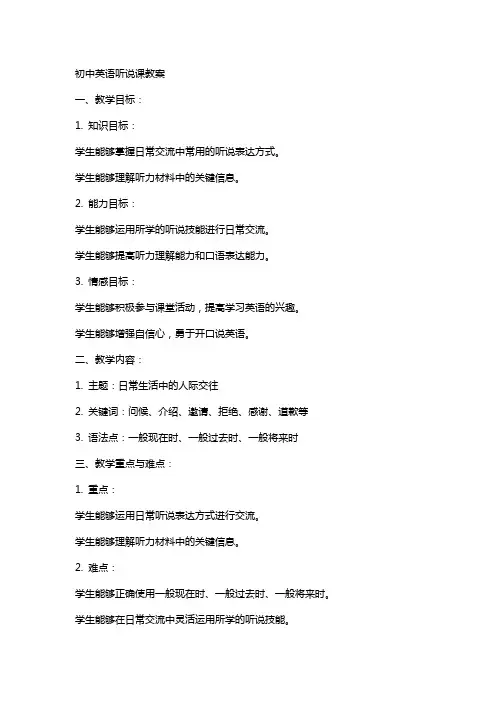
初中英语听说课教案一、教学目标:1. 知识目标:学生能够掌握日常交流中常用的听说表达方式。
学生能够理解听力材料中的关键信息。
2. 能力目标:学生能够运用所学的听说技能进行日常交流。
学生能够提高听力理解能力和口语表达能力。
3. 情感目标:学生能够积极参与课堂活动,提高学习英语的兴趣。
学生能够增强自信心,勇于开口说英语。
二、教学内容:1. 主题:日常生活中的人际交往2. 关键词:问候、介绍、邀请、拒绝、感谢、道歉等3. 语法点:一般现在时、一般过去时、一般将来时三、教学重点与难点:1. 重点:学生能够运用日常听说表达方式进行交流。
学生能够理解听力材料中的关键信息。
2. 难点:学生能够正确使用一般现在时、一般过去时、一般将来时。
学生能够在日常交流中灵活运用所学的听说技能。
四、教学方法:1. 任务型教学法:通过完成各种实际任务,激发学生的学习兴趣,提高学生的参与度。
2. 交际型教学法:通过模拟真实场景,培养学生的交际能力。
3. 视听教学法:利用多媒体教学资源,提高学生的听力理解能力。
五、教学过程:1. 热身活动(5分钟):教师与学生进行简单的英语对话,检查学生的英语水平。
学生进行小组活动,用英语进行自我介绍。
2. 听力活动(15分钟):学生听录音,回答问题。
教师引导学生进行听力技巧训练,如预测、关键词定位等。
3. 口语活动(10分钟):学生进行角色扮演,模拟真实场景进行对话。
教师引导学生注意口语表达的准确性和流畅性。
4. 课堂小结(5分钟):学生进行自我评价,反思学习过程中的优点和不足。
5. 作业布置:学生完成听力练习题。
学生准备下一节课的口语展示。
六、教学评价:1. 课堂参与度:观察学生在课堂活动中的参与情况,是否积极发言、主动交流。
2. 听力理解能力:通过听力练习题的正确率来评估学生的听力理解能力。
3. 口语表达能力:通过学生口语展示的表现来评估学生的口语表达能力。
七、教学反思:2. 教师要根据学生的反馈和自己的观察,调整教学方法,以提高教学效果。
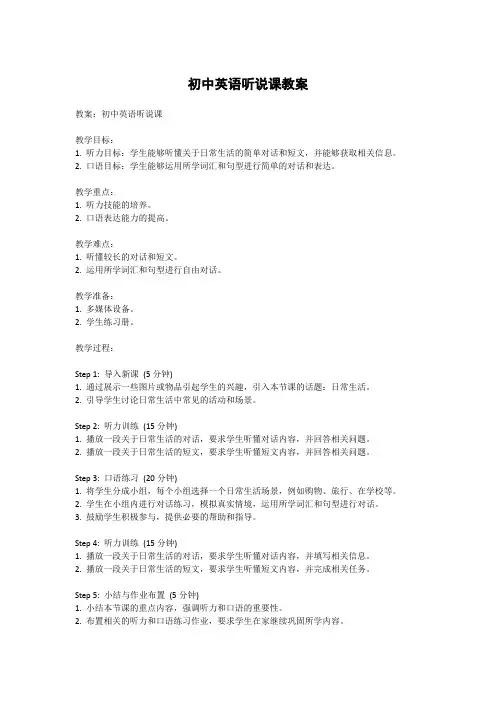
初中英语听说课教案教案:初中英语听说课教学目标:1. 听力目标:学生能够听懂关于日常生活的简单对话和短文,并能够获取相关信息。
2. 口语目标:学生能够运用所学词汇和句型进行简单的对话和表达。
教学重点:1. 听力技能的培养。
2. 口语表达能力的提高。
教学难点:1. 听懂较长的对话和短文。
2. 运用所学词汇和句型进行自由对话。
教学准备:1. 多媒体设备。
2. 学生练习册。
教学过程:Step 1: 导入新课(5分钟)1. 通过展示一些图片或物品引起学生的兴趣,引入本节课的话题:日常生活。
2. 引导学生讨论日常生活中常见的活动和场景。
Step 2: 听力训练(15分钟)1. 播放一段关于日常生活的对话,要求学生听懂对话内容,并回答相关问题。
2. 播放一段关于日常生活的短文,要求学生听懂短文内容,并回答相关问题。
Step 3: 口语练习(20分钟)1. 将学生分成小组,每个小组选择一个日常生活场景,例如购物、旅行、在学校等。
2. 学生在小组内进行对话练习,模拟真实情境,运用所学词汇和句型进行对话。
3. 鼓励学生积极参与,提供必要的帮助和指导。
Step 4: 听力训练(15分钟)1. 播放一段关于日常生活的对话,要求学生听懂对话内容,并填写相关信息。
2. 播放一段关于日常生活的短文,要求学生听懂短文内容,并完成相关任务。
Step 5: 小结与作业布置(5分钟)1. 小结本节课的重点内容,强调听力和口语的重要性。
2. 布置相关的听力和口语练习作业,要求学生在家继续巩固所学内容。
教学反思:本节课通过听力训练和口语练习相结合的方式,旨在提高学生的听力和口语能力。
通过听懂对话和短文,学生能够获取相关信息;通过口语练习,学生能够运用所学词汇和句型进行简单的对话和表达。
同时,通过小组合作的方式,激发学生的学习兴趣,提高学生的参与度。
在教学过程中,教师应注重学生的实际情况,根据学生的能力和兴趣进行差异化教学,提供必要的帮助和指导。
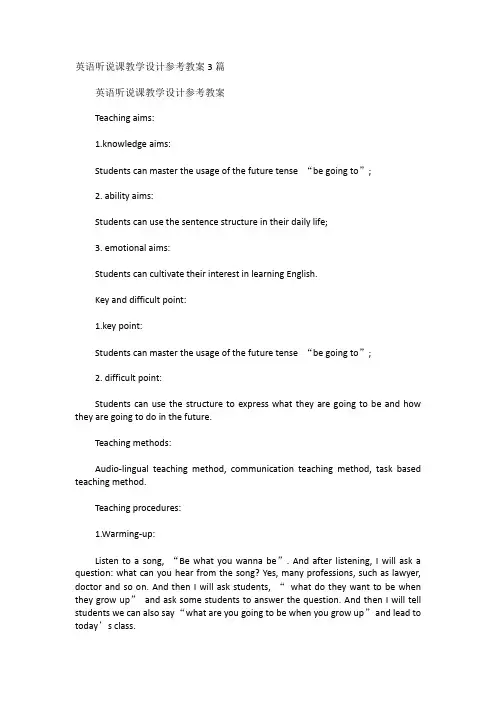
英语听说课教学设计参考教案3篇英语听说课教学设计参考教案Teaching aims:1.knowledge aims:Students can master the usage of the future tense “be going to”;2. ability aims:Students can use the sentence structure in their daily life;3. emotional aims:Students can cultivate their interest in learning English.Key and difficult point:1.key point:Students can master the usage of the future tense “be going to”;2. difficult point:Students can use the structure to express what they are going to be and how they are going to do in the future.Teaching methods:Audio-lingual teaching method, communication teaching method, task based teaching method.Teaching procedures:1.Warming-up:Listen to a song, “Be what you wanna be”. And after listening, I will ask a question: what can you hear from the song? Yes, many professions, such as lawyer, doctor and so on. And then I will ask students, “what do they want to be when they grow up”and ask some students to answer the question. And then I will tell students we can also say “what are you going to be when you grow up”and lead to today’s class.2. Pre-listening:I will show some pictures on the PPT, the first picture is about reporter and the second picture is about the article. I will write down the two words on the blackboard and then I will ask the students to read after me.3. While-listening:I will ask students to listen to the radio for the first time and then match the sentence with the picture on the ppt. The first picture is about the reporter, thee second picture is about writing magazines and the third picture is about Shanghai.Then I will ask students to listen to the radio for the second time and after listening, I will ask them to answer three questions on the blackboard, the first one is “What is he going to do when he grows up”, the second one is “how is he going to do for that”and the third one is “where is he going to work”.Lastly, I will ask students to listen to the radio for the third time and they need to read after the radio. And then I will divide the students into two groups, group A acts as A, and group B acts as B, and read the passage.4. Post-listeningWe will play a game called “hot potato”. When the music begins to play, students need to pass the flower. And when the music stops, the students who is holding the flower need to answer the question about “what is he going to do when he grows up, how is he going to do for that or where is he going to work”.And then we will have a group work, four students as a group and students need to make a survey about what is their group members going to be, how is he or she going to do for that and where is he going to work. Five minutes later, I will ask some groups to show their report.5. Summary and homeworkI will ask students to read the passage to summarize what we have learned today. After class, they need to search more information about the job they want to do.Blackboard designWhat are you going to be when you grow up?How are you going to do for that?Where are you going to work?英语听说课教学设计参考教案一、《英语课程标准》对初中阶段听、说的技能要求准确定位教学目标和宏观把握教学设计的依据是《课标》中规定的各级目标,教师要全面了解各学段的目标,以使自己在教学设计中能更好、更准确地把握。

初中初二英语听说课教案是英语教师设计的一份教学计划,其目的是帮助学生提高英语听说能力,包括听力和口语。
下面将为大家介绍初中初二英语听说课教案的设计及教学流程。
一、教案设计1.教学目标在教学过程中,教师首先要设定教学目标,确保学习效果。
初中初二英语听说课教案的教学目标包括以下方面:(1)培养学生对英语语音语调的感知和理解,掌握基本的语音规律和语感。
(2)提升学生听力水平,增强听力记忆和理解能力,训练听取重要信息的能力。
(3)锻炼学生表达、交流和演讲的能力,提高口语表达能力和口语交际策略。
2.课程安排初中初二英语听说课教案的课程安排是很重要的。
通常情况下,一节课时长为40分钟,教师可以按照以下要点来设计课程:(1)引入开课前,教师可以通过简短而有趣的引子引导学生进入课堂氛围,激发学生学习英语的兴趣。
(2)听力练习教师可以选择有趣、生动的听力材料,如英语短片、英语歌曲、英语广播等。
教师可以通过听力材料的选择和听力练习的设置,提高学生的听力水平和理解能力。
(3)口语训练教师可以设置丰富的口语训练环节,如小组讨论、角色扮演、情景交际等。
通过这些口语训练,教师可以帮助学生提高口语表达能力和口语交际策略。
(4)回顾总结课堂结束前,教师可以总结本课的重点内容,帮助学生梳理思路,加深印象。
二、教学流程1.引入教师可以通过播放有趣的英语短片或者电影片段来引入课堂。
并可以通过提问引导学生进行简短的讨论。
2.听力练习教师可以选择适合年龄和程度的听力材料,并根据学生的具体情况来选择听力练习的题型,如听力理解、听力填空、听力选择等。
在听力练习过程中,教师应当纠正学生发音错误,帮助学生提高利用上下文推断的能力。
3.口语训练教师可以通过小组讨论、角色扮演、情景交际等方式进行口语训练。
通过这些训练,教师可以帮助学生有效地运用所学英语知识,提高英语口语表达能力和交际策略。
4.回顾总结教师可以评价本节课所教授的知识点,帮助学生检查掌握情况,并对下一节课教授内容进行介绍,让学生知道下一步的学习目标。
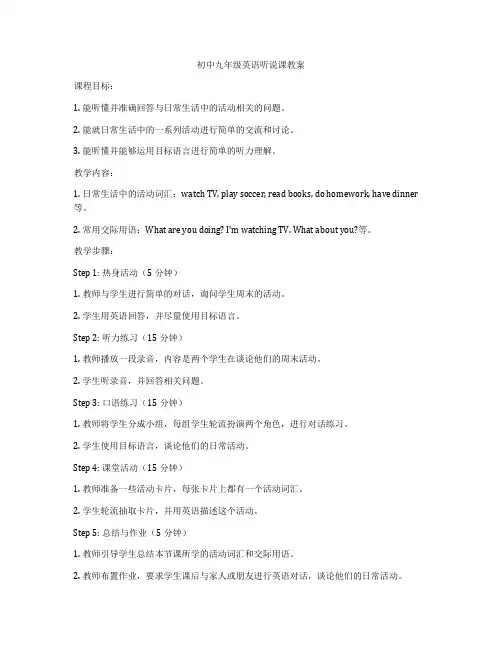
初中九年级英语听说课教案课程目标:1. 能听懂并准确回答与日常生活中的活动相关的问题。
2. 能就日常生活中的一系列活动进行简单的交流和讨论。
3. 能听懂并能够运用目标语言进行简单的听力理解。
教学内容:1. 日常生活中的活动词汇:watch TV, play soccer, read books, do homework, have dinner 等。
2. 常用交际用语:What are you doing? I'm watching TV. What about you?等。
教学步骤:Step 1: 热身活动(5分钟)1. 教师与学生进行简单的对话,询问学生周末的活动。
2. 学生用英语回答,并尽量使用目标语言。
Step 2: 听力练习(15分钟)1. 教师播放一段录音,内容是两个学生在谈论他们的周末活动。
2. 学生听录音,并回答相关问题。
Step 3: 口语练习(15分钟)1. 教师将学生分成小组,每组学生轮流扮演两个角色,进行对话练习。
2. 学生使用目标语言,谈论他们的日常活动。
Step 4: 课堂活动(15分钟)1. 教师准备一些活动卡片,每张卡片上都有一个活动词汇。
2. 学生轮流抽取卡片,并用英语描述这个活动。
Step 5: 总结与作业(5分钟)1. 教师引导学生总结本节课所学的活动词汇和交际用语。
2. 教师布置作业,要求学生课后与家人或朋友进行英语对话,谈论他们的日常活动。
教学评价:1. 课堂参与度:观察学生在课堂上的积极参与程度,以及他们的口语表达能力和听力理解能力。
2. 口语练习:评估学生在口语练习中的表现,包括语法准确性、词汇运用和对话流畅度。
3. 作业完成情况:检查学生作业的完成质量,包括语言表达的准确性和对话的内容丰富程度。
通过本节课的学习,学生能够提高他们的听说能力,并在日常生活中更好地运用英语进行交流。
同时,学生也能够增强对英语学习的兴趣和自信心。
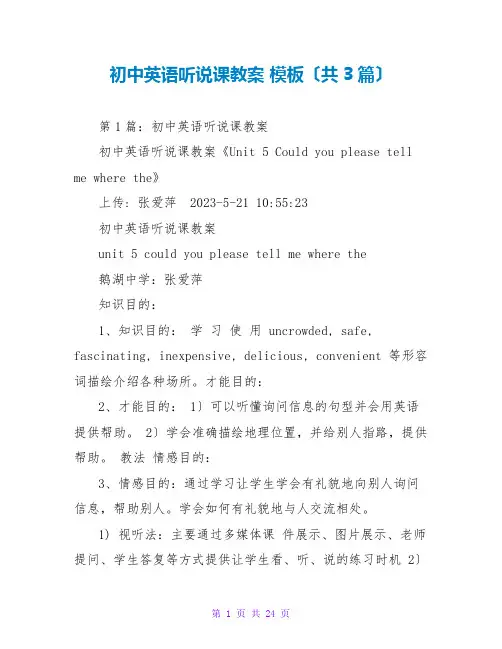
初中英语听说课教案模板〔共3篇〕第1篇:初中英语听说课教案初中英语听说课教案《Unit 5 Could you please tell me where the》上传: 张爱萍 2023-5-21 10:55:23初中英语听说课教案unit 5 could you please tell me where the鹅湖中学:张爱萍知识目的:1、知识目的:学习使用 uncrowded, safe, fascinating, inexpensive, delicious, convenient 等形容词描绘介绍各种场所。
才能目的:2、才能目的: 1〕可以听懂询问信息的句型并会用英语提供帮助。
2〕学会准确描绘地理位置,并给别人指路,提供帮助。
教法情感目的:3、情感目的:通过学习让学生学会有礼貌地向别人询问信息,帮助别人。
学会如何有礼貌地与人交流相处。
1) 视听法:主要通过多媒体课件展示、图片展示、老师提问、学生答复等方式提供让学生看、听、说的练习时机 2〕问答法:展示各种图片,让学生利用这些图片进展交流,互学法相问答,让学生在做中学,在实践中获得信息,习得英语。
3〕施行情境教学法 4〕采用任务型语言教学多媒体录音机学具师生活动设计1〕学生课前预习法 2〕小组合作探究法 3〕情感谢励法教具教学程序设计教材处理设计课件一、谈图片,谈图片,复习热身step1 warming up :复习热身 greet the cla.look at the pictures.【出示 section a 中 2a 的图片, 让学生考虑, 准备介绍分别可以在哪买到 book,shoes, shoo 等物品,如何找到该地方。
复习前面学过的句型,为本课的顺利进展,尤其是听力的顺利展开打好根底。
…… 】老师出示一些商业店铺的图片,学生两人一组练习:该在哪里买到相应物品?如何到达目的地?即练习问路的表达法和如何指路的表达法。
复习 where, how 引导的宾语从句。
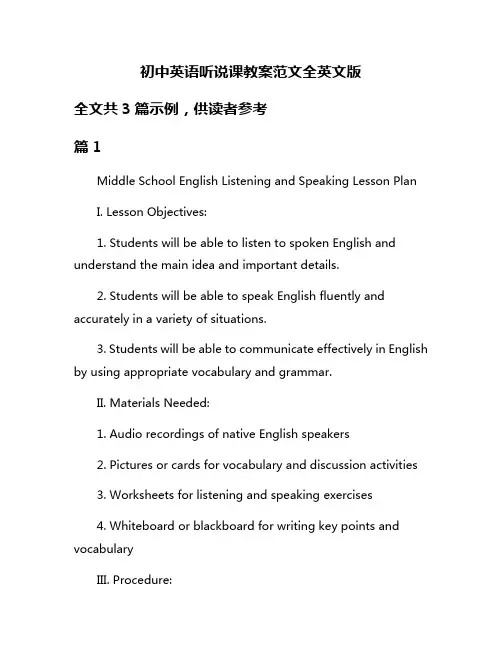
初中英语听说课教案范文全英文版全文共3篇示例,供读者参考篇1Middle School English Listening and Speaking Lesson PlanI. Lesson Objectives:1. Students will be able to listen to spoken English and understand the main idea and important details.2. Students will be able to speak English fluently and accurately in a variety of situations.3. Students will be able to communicate effectively in English by using appropriate vocabulary and grammar.II. Materials Needed:1. Audio recordings of native English speakers2. Pictures or cards for vocabulary and discussion activities3. Worksheets for listening and speaking exercises4. Whiteboard or blackboard for writing key points and vocabularyIII. Procedure:1. Warm-up (5 minutes): Play a short audio clip of English conversation and ask students to listen and discuss what they heard in pairs. This will help students get into the listening mode and activate their listening skills.2. Vocabulary Introduction (10 minutes): Introduce new vocabulary related to the audio clip or the theme of the lesson. Use pictures or cards to help students understand and remember the words better.3. Listening Activity (20 minutes): Play an audio recording ofa native English speaker talking about a specific topic. Ask students to listen carefully and take notes on the main points and important details. After the recording, lead a class discussion on what they heard and check their understanding.4. Speaking Practice (20 minutes): Divide students into small groups and give them a speaking task related to the listening activity. For example, ask them to discuss their opinions on the topic, role-play a conversation based on the audio clip, or make a presentation using the information they learned.5. Feedback and Evaluation (10 minutes): Provide feedback on students' language use and communication skills during the speaking practice. Encourage peer evaluation andself-assessment to help students improve their English proficiency.6. Wrap-up (5 minutes): Review the key vocabulary and language structures learned in the lesson. Assign homework or additional speaking activities for students to practice outside of class.IV. Assessment:1. Listening comprehension: Evaluate students' ability to understand spoken English and follow the main ideas and details.2. Speaking fluency: Assess students' ability to speak English confidently and fluently in a variety of situations.3. Vocabulary and grammar: Evaluate students' use of appropriate vocabulary and grammar in their speaking activities.V. Extension Activities:1. Listen to more audio recordings of different accents and speech patterns to expose students to a variety of English language styles.2. Conduct pair or group discussions on different topics to practice speaking and listening skills in a more interactive setting.3. Organize a speaking competition or debate among students to enhance their communication and presentation skills in English.Overall, this lesson plan aims to improve students' listening and speaking skills in English through interactive and engaging activities. By providing opportunities for students to listen to authentic language input and practice speaking in meaningful contexts, they will develop the confidence and proficiency needed to communicate effectively in English.篇2Middle school English Listening and Speaking Lesson PlanLesson Title: Introducing YourselfGrade Level: Middle schoolObjective: Students will be able to introduce themselves and talk about their likes, dislikes, and interests in English.Materials: Whiteboard, markers, flashcards with vocabulary words, pictures of different activitiesWarm-up (10 minutes):- Begin the lesson by asking students to stand up and form a circle.- Lead them in a game of passing a ball around the circle while saying their names.- This will help students get comfortable speaking in English and creating a positive classroom atmosphere.Introduction (5 minutes):- Write the following questions on the board: What is your name? How old are you? Where are you from?- Explain that today's lesson will focus on introducing themselves in English and talking about their likes and dislikes.Presentation (15 minutes):- Use flashcards with vocabulary words related to hobbies, likes, and dislikes.- Give examples of sentences like "I like swimming" or "I don't like playing video games" and ask students to repeat after you.- Show pictures of different activities and ask students to talk about whether they like or dislike them.Practice (20 minutes):- Divide students into pairs and have them take turns introducing themselves to each other.- Encourage them to ask questions and find common interests.- Walk around the classroom and listen to students speaking in English, offering help and corrections as needed.Production (15 minutes):- Have each student stand up and introduce themselves to the class.- Encourage them to use the vocabulary and sentence structures they have learned.- After each student has introduced themselves, ask the class to guess their likes and dislikes based on their presentation.Wrap-up (5 minutes):- Review the vocabulary and sentence structures learned in the lesson.- Encourage students to continue practicing introducing themselves in English outside of the classroom.- Assign homework to write a short paragraph about themselves, including their name, age, hometown, and likes and dislikes.Extension:- For advanced students, have them create a dialogue with a partner where they introduce themselves and have a conversation about their interests.- Play a game where students have to guess each other's likes and dislikes based on clues given by their partner.This lesson plan is designed to help middle school students improve their English listening and speaking skills through interactive activities and practice. By focusing on introducing themselves and talking about their likes and dislikes, students will become more confident in using English in real-life situations.篇3Middle School English Listening and Speaking Lesson PlanI. Lesson Title: My HobbiesII. Objectives:1. Students will be able to introduce themselves and talk about their hobbies.2. Students will practice listening to a conversation about hobbies.3. Students will practice speaking about their own hobbies.III. Materials Needed:1. Whiteboard and markers2. Audio recording of a conversation about hobbies3. Handouts with vocabulary related to hobbiesIV. Procedure:1. Warm-up (10 minutes):- Begin the lesson by asking students to share their favorite hobbies with the class.- Write down some of the hobbies on the board and discuss them briefly.- Introduce the topic of the lesson: My Hobbies.2. Listening (15 minutes):- Play the audio recording of a conversation between two people talking about their hobbies.- After the recording, ask students some comprehension questions to check understanding.- Discuss any new vocabulary that was introduced in the conversation.3. Speaking (20 minutes):- Divide the class into pairs and ask students to talk to their partner about their own hobbies.- Encourage students to ask follow-up questions and engage in a conversation with their partner.- Walk around the class and monitor the students' discussions, offering feedback and assistance where needed.4. Vocabulary Practice (10 minutes):- Hand out the vocabulary handouts to the students.- Have students work in pairs or small groups to match the hobbies with their definitions.- Review the answers as a class and discuss any questions or misunderstandings.5. Role Play (15 minutes):- Divide the class into groups of four.- Assign each group a scenario related to hobbies (e.g. planning a weekend activity, discussing a new hobby).- Have students perform the role play in front of the class.- After each role play, provide feedback on the students' performance and language use.6. Wrap-up (5 minutes):- Review the main points of the lesson and ask students to share one thing they learned or enjoyed.- Assign homework for the next class, such as writing a short paragraph about their favorite hobby.V. Assessment:- Students will be assessed on their ability to participate in the speaking activities, engage in conversations with their peers, and use vocabulary related to hobbies accurately.VI. Extension Activities:- Have students create a poster or presentation about their hobbies to share with the class.- Organize a hobby fair where students can display and talk about their hobbies with their classmates.VII. Reflection:- After the lesson, reflect on what went well and what could be improved for future lessons on the topic of hobbies in English listening and speaking.。
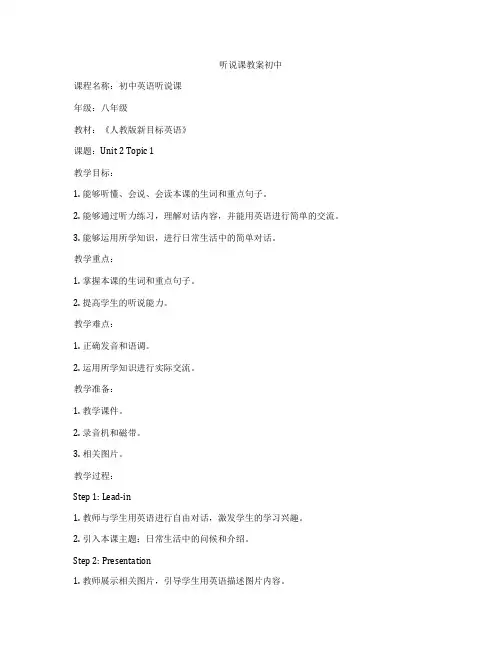
听说课教案初中课程名称:初中英语听说课年级:八年级教材:《人教版新目标英语》课题:Unit 2 Topic 1教学目标:1. 能够听懂、会说、会读本课的生词和重点句子。
2. 能够通过听力练习,理解对话内容,并能用英语进行简单的交流。
3. 能够运用所学知识,进行日常生活中的简单对话。
教学重点:1. 掌握本课的生词和重点句子。
2. 提高学生的听说能力。
教学难点:1. 正确发音和语调。
2. 运用所学知识进行实际交流。
教学准备:1. 教学课件。
2. 录音机和磁带。
3. 相关图片。
教学过程:Step 1: Lead-in1. 教师与学生用英语进行自由对话,激发学生的学习兴趣。
2. 引入本课主题:日常生活中的问候和介绍。
Step 2: Presentation1. 教师展示相关图片,引导学生用英语描述图片内容。
2. 教师介绍本课的生词和重点句子,并用身体语言和表情帮助学生理解。
Step 3: Practice1. 学生两人一组,用英语进行问候和介绍的练习。
2. 教师巡回指导,纠正学生的错误。
Step 4: Listening1. 教师播放磁带,学生听对话并回答问题。
2. 教师检查学生的听力理解能力,并给予反馈。
Step 5: Speaking1. 学生两人一组,进行角色扮演,模拟日常生活中的问候和介绍。
2. 教师巡回指导,纠正学生的错误。
Step 6: Consolidation1. 学生进行小组活动,用英语进行对话交流。
2. 教师选取小组代表进行汇报,给予评价和反馈。
Step 7: Summary1. 教师对本课内容进行总结,强调重点。
2. 学生进行自我评价,教师给予鼓励和指导。
Step 8: Homework1. 学生回家后,听磁带并跟读,提高发音和语调。
2. 家长签字确认,加强家校合作。
教学反思:本节课通过听说教学法,帮助学生掌握日常生活中的问候和介绍。
在教学过程中,教师应注重学生的参与和实际操作,鼓励学生大胆开口说英语。
浙江省初中英语听说课教案课程目标:1. 能听懂并准确回答与日常生活中的购物相关的问题。
2. 能够用英语进行简单的购物对话。
3. 提高学生的听说能力,培养他们的交际技巧。
教学内容:1. 单词:clothing, shoes, hat, bag, earrings, watch, scarf, sunglasses2. 短语:try on, how much, is it, size, color, I'll take, that's too expensive3. 句子:Can I help you find something?, Yes, I'm looking for..., How much is this?, Can I try this on?, I'll take this one, That's too expensive, I need a bigger/smaller size.教学步骤:Step 1: 热身活动(5分钟)1. 教师与学生进行简单的英语对话,激发学生的听说兴趣。
2. 学生进行小组活动,用英语介绍自己的服装和配饰。
Step 2: 听力练习(15分钟)1. 教师播放一段关于购物的对话录音,学生听后回答问题。
2. 学生听录音并完成相关的听力练习题。
Step 3: 口语练习(15分钟)1. 教师引导学生进行购物对话的角色扮演,学生分组进行练习。
2. 学生向全班展示他们的对话,其他学生可以提出问题或给予评价。
Step 4: 扩展活动(10分钟)1. 教师给出一个购物场景,学生分组讨论并制定购物计划。
2. 学生向全班介绍他们的购物计划,其他学生可以提出问题或给予建议。
Step 5: 总结与作业(5分钟)1. 教师与学生一起回顾本节课所学内容,巩固知识点。
2. 学生完成一份相关的听力练习作为作业。
教学评价:1. 通过听力练习和口语练习,教师可以评估学生的听说能力。
教案:初中英语听说课课程名称:初中英语听说课课程目标:1. 让学生能够听懂并运用本课所学词汇和句型进行简单的日常交流。
2. 提高学生的听说能力,培养学生的语言运用能力。
3. 激发学生学习英语的兴趣,增强学生的自信心。
教学内容:1. 词汇:学校、学科、颜色、数字等。
2. 句型:介绍自己、询问他人信息、表达喜好等。
3. 听力材料:关于学校生活的对话。
教学步骤:Step 1: 热身活动(5分钟)1. 教师与学生进行简单的自由对话,询问学生关于学校生活的方方面面。
2. 学生进行小组活动,用英语介绍自己的学校生活,包括学科、兴趣爱好等。
Step 2: 词汇学习(10分钟)1. 教师出示词汇卡片,引导学生跟读并记忆词汇。
2. 学生进行小组活动,用所学词汇进行简单的交流。
Step 3: 句型学习(10分钟)1. 教师出示句型卡片,引导学生跟读并理解句型。
2. 学生进行小组活动,用所学句型进行交流。
Step 4: 听力练习(15分钟)1. 教师播放听力材料,学生听后回答问题。
2. 学生进行小组活动,互相练习听力材料中的对话。
Step 5: 口语表达(10分钟)1. 教师出示话题卡片,引导学生进行口语表达。
2. 学生进行小组活动,用所学词汇和句型进行口语表达。
Step 6: 总结与作业(5分钟)1. 教师对本次课程进行总结,强调重点词汇和句型。
2. 学生完成作业,巩固所学内容。
教学评价:1. 观察学生在课堂上的参与程度和听说能力的提升。
2. 对学生的口语表达进行评价,鼓励学生的进步。
教学资源:1. 词汇卡片。
2. 句型卡片。
3. 听力材料。
教学建议:1. 教师应注重学生的听说能力的培养,鼓励学生积极参与课堂活动。
2. 教师应给予学生足够的练习机会,让学生在实际交流中运用所学知识。
3. 教师应关注学生的个体差异,因材施教,给予每个学生适当的指导和支持。
以上是一份关于初中英语听说课的教案,希望能对您的教学有所帮助。
初中英语听说课教案一、教学目标1. 知识目标:学生能够掌握日常对话中常用的听说表达方式。
学生能够通过听力练习,理解并运用关键词汇。
2. 能力目标:学生能够提高英语听说能力,能够在日常生活中进行简单的英语交流。
学生能够通过听力训练,提高对英语语音和语调的辨识能力。
3. 情感目标:学生能够积极参与课堂活动,增强学习英语的兴趣。
学生能够通过与他人的交流,培养合作和分享的精神。
二、教学内容1. 教材:人教版《初中英语》听说教材。
2. 主题:日常生活中的对话。
3. 关键词汇:greetings, introduction, self-introduction, asking for directions, ordering food等。
三、教学过程1. 热身活动(5分钟):教师与学生进行简单的英语问候,营造轻松的课堂氛围。
学生进行小组活动,用英语进行自我介绍。
2. 听力练习(15分钟):学生听录音,回答问题。
教师引导学生关注关键词汇和语音语调。
3. 口语练习(15分钟):学生进行角色扮演,模拟日常对话。
教师提供反馈,纠正发音和语法错误。
四、教学评价1. 课堂参与度:观察学生在课堂活动中的积极性。
2. 听力理解能力:通过课后作业和课堂练习,评估学生的听力水平。
3. 口语表达能力:通过角色扮演和小组讨论,评估学生的口语能力。
五、教学资源1. 教材:人教版《初中英语》听说教材。
2. 录音设备:用于播放听力材料。
3. 投影仪:用于展示PPT和教学内容。
4. 教学卡片:用于辅助教学,展示关键词汇和短语。
六、教学步骤1. 听力训练(20分钟):学生听录音,完成相应的练习。
教师引导学生关注听力技巧,如预测、关键词查找等。
2. 口语表达(20分钟):学生进行小组活动,用英语进行讨论。
教师提供反馈,纠正发音和语法错误。
七、教学策略1. 任务型教学法:通过听力任务和口语任务,提高学生的实际应用能力。
2. 交际法:鼓励学生进行真实交流,培养他们的交际能力。
初中英语听说课优秀教案初中英语课堂中,听说课程是极为重要的一部分。
在教学中如何设计优秀的听说教案,对提高学生的英语听说能力起到非常重要的推动作用。
本文将围绕初中英语听说课优秀教案这一主题,从听说课的重要性、教案设计、教学方法和策略四个方面进行探讨。
一、听说课的重要性听说是语言交际的两大基本技能,是英语学习的重点。
学生通过听说课程可以掌握英语语音、语调、语音语音语调和表达能力的提升,培养自信和兴趣。
同时,听说课程还可以增强学生的语感、理解能力、表达能力和沟通能力,有助于促进学生的交际能力、社会交往能力等方面的提高。
二、教案设计1. 教学目的:要明确听说课的教学目标,包括教育目标和知识点。
教育目标以学科核心素养为主,教育价值和社会价值以及在生活中的运用。
知识点是词汇、语法结构、语音语调等方面。
2. 教学内容:在教学内容上,除了要结合教材要求,注重自己的选择和设计,包括内容的整合,如词汇、语法和语音的整合。
3. 教学过程:要注重教学过程的设计,包括通常的教学模式的选择,教学方法的选择,并以教学工具、技术为支持。
三、教学方法1. 听力训练:集中注意力听录音或视频,强化口语训练,提升听力和口语技巧。
2. 视觉训练:通过图片、动画等视觉材料来进行口语训练,可以激发学生兴趣,提高口语表达能力。
3. 交际训练:通过组织学生交流、互动、讨论等方式,加强学生的口语交流能力,促进学生的合作精神和团队精神。
4. 任务型教学:任务型教学是强调行动和任务的教学模式,容易引起学生兴趣,提高他们的参与度和积极性,增强口头表达能力。
四、教学策略1. 应用主题策略:将教材融入问题与主题中,让学生在生活中掌握英语交际能力。
2. 应用情境策略:通过各种生活情境,让学生理解英语语言运用的意义和重要性,提高口语表达的自信心。
3. 醒目策略:需要引导学生通过口语来试图回答一些人们最感兴趣的问题。
4. 目标确定策略:让学生明确目标,及时清理好英语表达的要素,有助于提高口语交流效果。
【课程名称】初中英语听说课程【授课年级】初中年级【授课班级】XX班【课时安排】2课时【教学目标】1. 语言技能目标:- 学生能够理解并运用常见的听力技巧,如听大意、听具体信息、猜词义、听细节等。
- 学生能够流利地进行日常对话,表达自己的观点和想法。
2. 知识目标:- 学生能够掌握相关话题的词汇和短语,如时间、地点、人物、事件等。
- 学生能够识别并理解基本的语法结构。
3. 情感态度目标:- 学生能够积极参与课堂活动,提高学习英语的兴趣。
- 学生能够增强自信心,提高英语交流能力。
【教学重难点】1. 重点:- 听力技巧的运用。
- 日常对话的表达。
2. 难点:- 词汇和短语的准确使用。
- 语法结构的理解与运用。
【教学准备】1. 教师准备:- 教学课件、音频材料、图片等。
- 听力练习题、口语练习题。
2. 学生准备:- 笔记本、笔。
- 积极参与课堂活动的心态。
【教学过程】第一课时一、导入(5分钟)1. 老师通过图片、视频等形式,展示与话题相关的场景,激发学生的兴趣。
2. 学生分享自己对相关话题的了解和看法。
二、听力训练(15分钟)1. 老师播放听力材料,学生边听边做笔记。
2. 学生汇报听到的内容,老师点评并纠正错误。
三、词汇和短语学习(15分钟)1. 老师讲解与话题相关的词汇和短语,并举例说明。
2. 学生练习使用这些词汇和短语进行对话。
四、口语练习(15分钟)1. 老师设计情景对话,学生分组进行角色扮演。
2. 老师点评学生的口语表达,给予指导和建议。
第二课时一、复习(5分钟)1. 学生回顾上一节课的学习内容,老师提问检查学生的掌握情况。
二、听力巩固(15分钟)1. 老师播放新的听力材料,学生完成听力练习。
2. 学生汇报听力内容,老师点评并纠正错误。
三、口语提高(15分钟)1. 老师设计更复杂的情景对话,学生分组进行角色扮演。
2. 老师点评学生的口语表达,给予指导和建议。
四、总结(5分钟)1. 老师总结本节课的学习内容,强调重点和难点。
课时:1课时年级:八年级教材:《初中英语》人教版教学目标:1. 听力目标:学生能够听懂日常生活中的简单对话,理解对话的主要内容。
2. 口语目标:学生能够用英语进行简单的日常交流,表达自己的观点和感受。
3. 知识目标:学生能够掌握一些常用的日常用语和表达方式。
4. 情感态度目标:培养学生对英语学习的兴趣,提高学生的跨文化交际意识。
教学重难点:1. 重点:理解对话的主要内容,掌握日常用语的表达方式。
2. 难点:在真实的语境中运用所学知识进行交流。
教学准备:1. 多媒体课件2. 课文音频3. 任务卡4. 小组活动记录表教学过程:一、导入(5分钟)1. 播放一首与主题相关的英语歌曲,活跃课堂气氛。
2. 引导学生谈论歌曲中的内容,激发学生的学习兴趣。
二、听力训练(15分钟)1. 播放课文音频,让学生听懂对话的主要内容。
2. 学生听后,回答以下问题:- What are they talking about?- Who are they?- What do they want to do?三、口语练习(20分钟)1. 教师讲解本节课的日常用语和表达方式,如:How are you? What's your name? I'm fine, thank you. Nice to meet you. 等。
2. 学生进行角色扮演,模拟对话场景,如:自我介绍、询问对方信息等。
3. 小组活动:每组选择一个场景,进行对话练习,其他组员旁听并给予评价。
四、巩固练习(10分钟)1. 教师提供一些日常生活中的情景,让学生用所学知识进行口头表达。
2. 学生轮流进行口头表达,其他学生给予评价。
五、总结与作业(5分钟)1. 教师对本节课的内容进行总结,强调重点和难点。
2. 布置作业:- 复习本节课的日常用语和表达方式。
- 预习下一节课的内容。
教学反思:1. 本节课通过听力训练和口语练习,提高了学生的英语听说能力。
2. 在教学过程中,教师应注重培养学生的跨文化交际意识,鼓励学生在日常生活中运用所学知识。